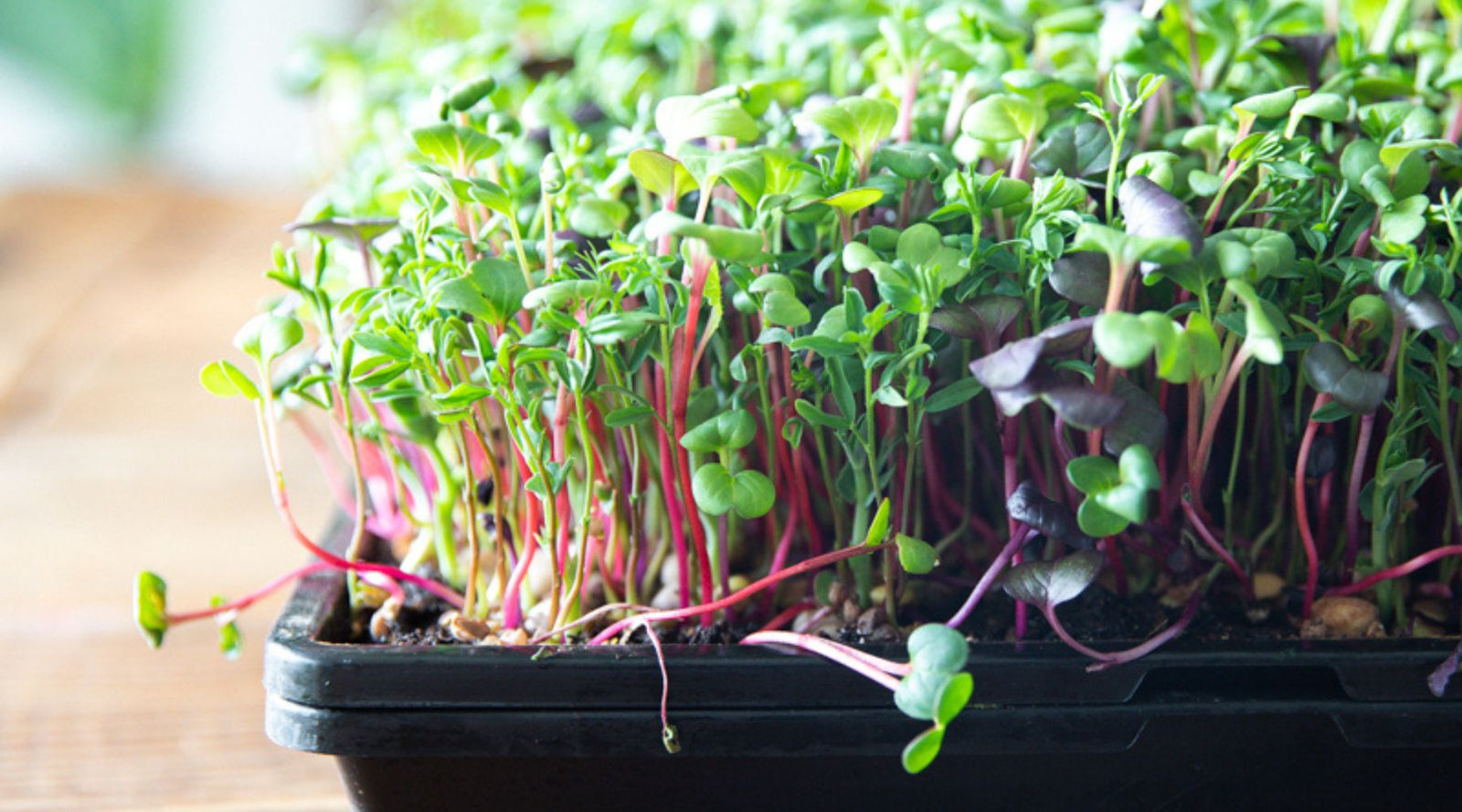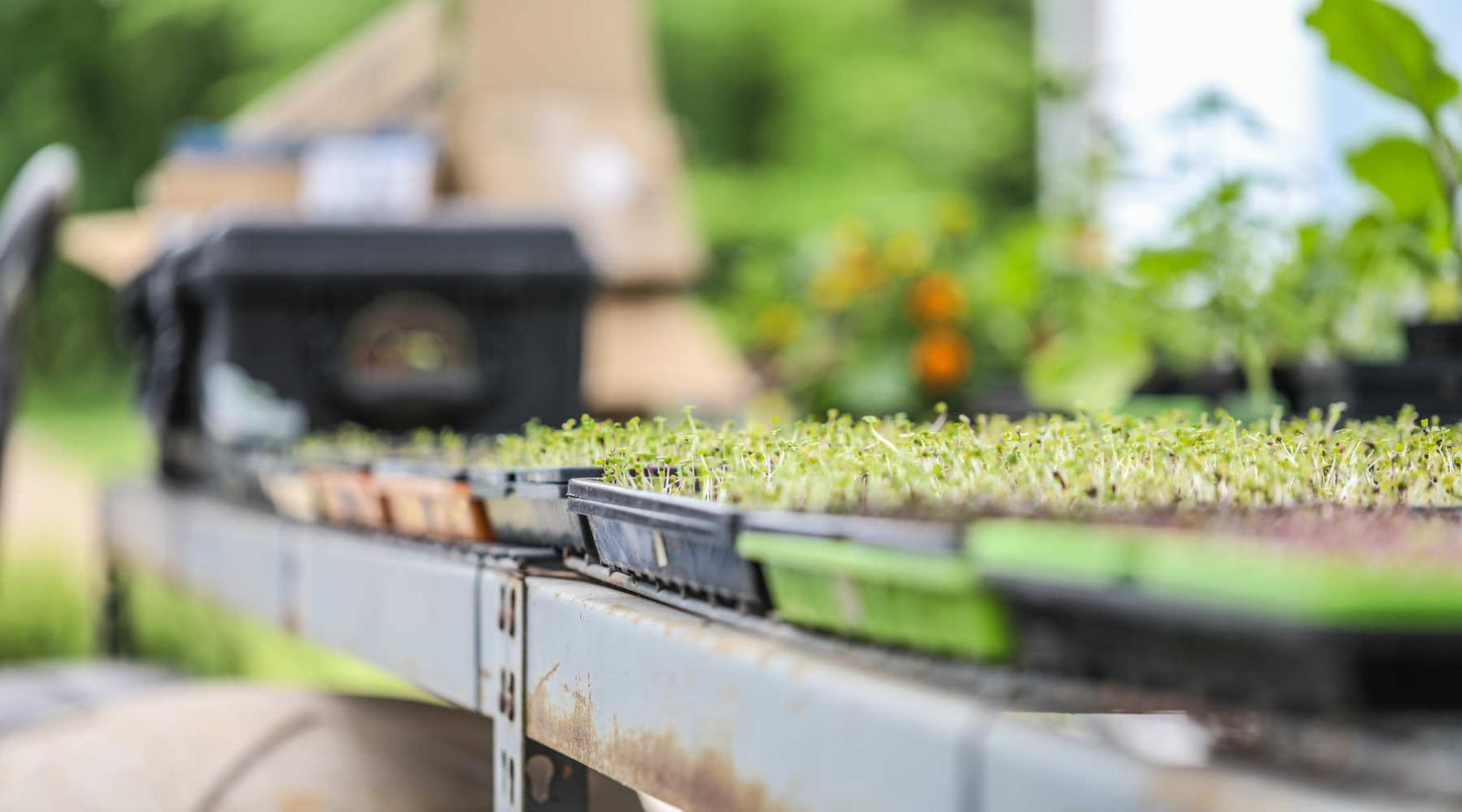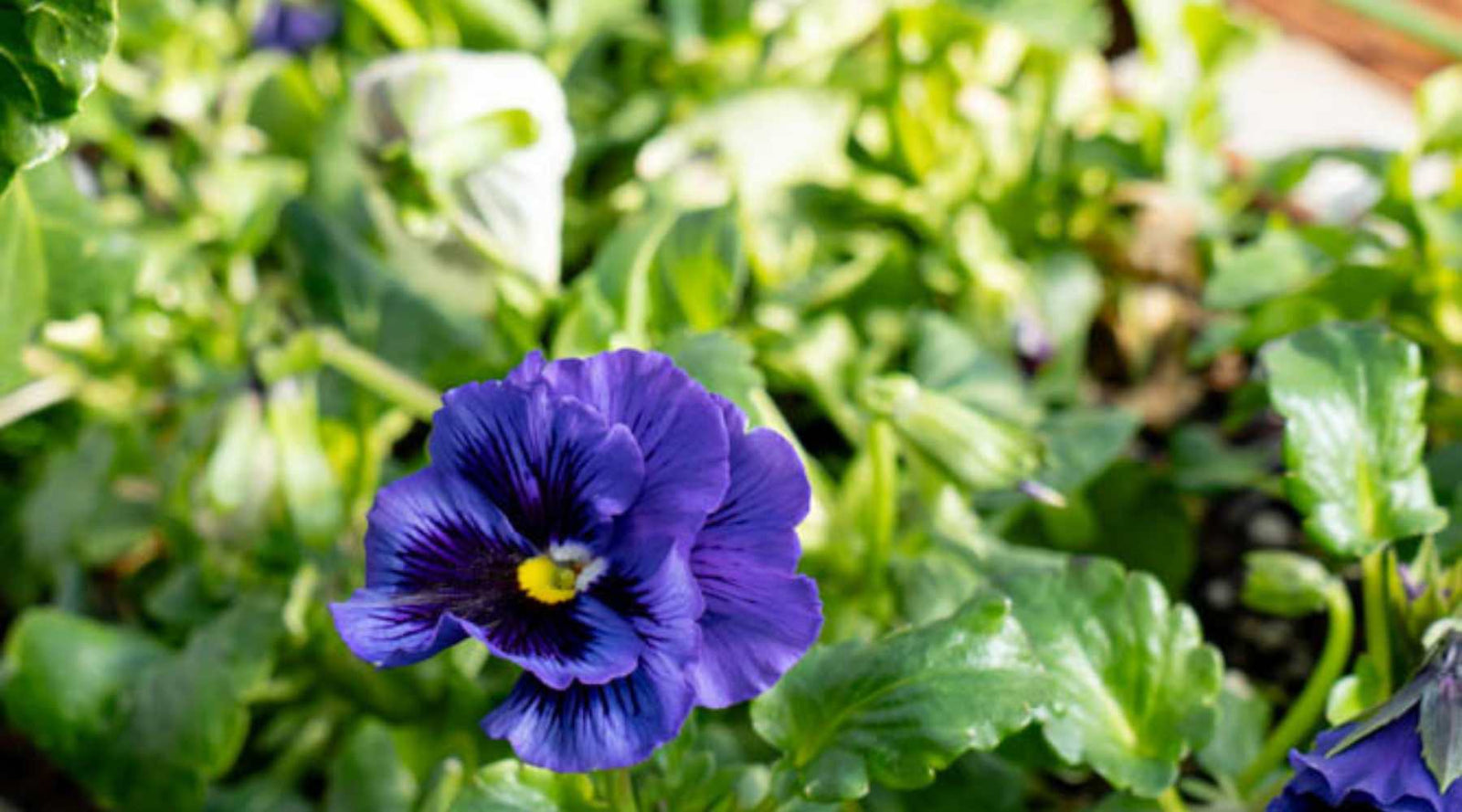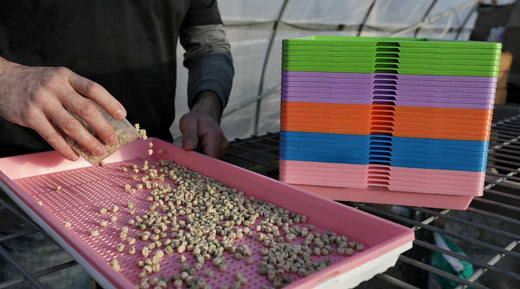Free Shipping on Orders over $75 to the Contiguous US
Free Shipping on Orders over $75 to the Contiguous US
How to Water Microgreens | Which Method is Best?
December 27, 2023 7 min read 0 Comments

Watering Microgreens
Microgreens can be watered in several different ways, by way of top watering, bottom watering, and in an automated flood and drain system. The type of method you will use will depend on what stage of growth your microgreens are in and the growing requirements of the microgreen variety.
The top watering method of microgreens is best suited for just prior to and after planting, right before your tray has reached the germination stage. Growers use a hose or water spray bottle with a fine mist setting to accomplish this.
Watering from the bottom is the best way to water your growing microgreens after they have sprouted, either with the use of a flood and drain system or a bottom tray with no holes. In order to reduce the risk of mold, protect tender stems from damage, and ensure that each tiny plant has access to the right amount of moisture, avoid wetting the leaves.
How to water microgreen seeds when planting
When you first seed your microgreen trays is, in most cases, the only time you should water from above. Before you place the seed on the soil ensure that your growing media has the moisture level of a lightly wrung-out sponge. It should be quite damp but without any pooling water. You can do this with your spray bottle or by moistening the growing media before placing it in the tray.
Spread your seeds evenly across the surface of your growing media. Using the fine mist setting will avoid displacing small seeds as you water. Evenly mist the entire tray so the seeds are visibly damp. Place the trays under a humidity dome or stack them on top of one another with a no-hole tray between each growing tray. Read How to Use a Humidity Dome for Seed Starting to learn more about using humidity domes when growing microgreens.
If your growing space is quite warm or has very low ambient humidity you may need to mist the trays once a day until germination occurs. These daily mistings should be quite light to avoid pooling water on top of the soil in your trays which can lead to mold. Check out Mold on Microgreens- How to Prevent and Combat Mold for more guidance on avoiding mold issues in your microgreens.
As soon as you see those little cotyledon leaves peeking out it is time to switch to bottom watering. Not sure what microgreen varieties to plant? Check out the Top 10 Microgreens to Grow for some great suggestions.
What kind of mister should you use for microgreens?
Pump sprayers or atomizers are the best to use for indoor growing. These types of bottles allow you to pump air into the bottle and use the pressure to evenly distribute a fine spray that will not displace seeds. Unlike trigger spray bottles they will not cause hand fatigue or generate a case of trigger finger.
If you are seeding less than 10 trays at a time the 2-liter size pump sprayers with adjustable nozzles are great. If you have more trays than that to plant at a time, many companies make a backpack-style pump sprayer that can hold more water.
Pump sprayers can be found in just about any garden supply store in the fertilizer/pesticide section. Just make sure to label your sprayer and only use it for water. It can be handy to have a second sprayer on hand for your 3% hydrogen peroxide solution used for sterilizing trays and seeds.
We all know that trying to bring a hose inside is a recipe for problems. But if you are growing your microgreens in a hoop house or greenhouse you can use the fine mist setting on your hose sprayer or buy a dedicated mister nozzle for the ideal fine mist.
What is the best technique to water microgreens after germination?
Watering your microgreens from the bottom is the best way to avoid mold issues and leaf damage after germination has occurred. If you are using a combination of a shallow 1020 tray with holes and a 1020 tray with no holes underneath this technique is easy to accomplish.
- Lift the tray with holes and growing media up from one end and add 1 ½ to 2 cups of water to the bottom tray.
- Slowly lower the top tray back down to avoid splashing water.
- Check the moisture content of your growing media after about 20 minutes
- If it is not completely moist add another cup of water. If it is overly saturated, reduce the amount of water you add next time.
- Do not try to add more than 2 cups at a time as this can cause water to come out the sides of the tray before it has time to absorb.
How Often Should You Water Microgreens?
The frequency of watering required for microgreens depends on the variety, the growing conditions, and the tray's growth stage. A good baseline is at least once a day. You want your trays to be moist but not sopping wet. Healthy microgreens need oxygen for their root systems to thrive, so stale water should never sit on the bottom of the tray after watering. For this reason, it is a good idea to dial in your plant’s watering needs to avoid the excess.
The amount and frequency of watering that your plants will need increases over the span of the grow. Newly germinated microgreens may only need 1 ½ cups of water once a day for the first few days. Once they are larger, a day or two before harvest, they may need to be watered twice a day.
For example: Larger plants like peas and sunflowers may need up to 2 cups of water a day added to the bottom tray twice a day in order to avoid wilting when they are close to harvest. While 1 ½ cups once a day is plenty at the start of the grow.
The bigger the plants the more water they can consume in a 24 hour period. Smaller plants like micro basil or micro broccoli typically only need to be watered once a day for their entire growing cycle.
How do you prevent mold from growing on your microgreens?
Mold issues on microgreens can be actively discouraged by managing the growing space's environment, paying attention to the seeding rate, and keeping up with good grow room hygiene. Read more about prevention in Mold on Microgreens: How to Prevent and Combat Mold.
Managing the humidity levels and ventilation in your grow room will help minimize the risk of mold growth. Ideally, you will want to keep your humidity levels between 40% and 50%. Adding an oscillating fan or a small grow rack fan into your space is another way to provide your plants with the optimal environment. The air flow generated has the added benefit of strengthening and thickening the stems on your plants. This helps to prevent them from falling over as they get taller and adding to your harvestable weight.
Often growers will seed their trays too densely. This is an issue for two main reasons. One, it will cause the plants to grow up crowded, which will reduce the airflow. Two, it increases the likelihood that you will have unsprouted seeds on the soil surface leading to mold growth on the surface of the seed coat. Check out the Ultimate Microgreen Growing Resource for a chart of seeding rates for all of your favorite microgreen varieties.
Grow room hygiene is key when preventing mold from becoming an issue. If you spill soil, clean it up. If you drip water, make sure you have towels on hand to dry it. The cleaner you keep your grow space, the better. This also goes for microgreen trays. Check out How to Wash and Care for Seedling Trays for more information on properly cleaning microgreen trays.
Do you need to test your water for watering microgreens?
Water quality is very important when growing microgreens. If using a municipal water system, you may find you have high levels of chlorine. If growing from rural or well water, you may find that you have extremely hard water with a high amount of dissolved minerals.
If using a water softening system, you might run into issues with the salts used in the process of softening the water. Bring a small sample in for testing and determine from there whether you will want to install a Reverse Osmosis system or if the water available to you will work without treatment.
What is an ideal pH for growing microgreens?
Microgreens tend to do best with a slightly acidic pH of 5.5-6.5. Most municipalities have water that is slightly alkaline with a pH of around 7. There are a few ways to adjust this in order to have the ideal pH for growing.
You will need to test your water first using pH indicator strips or pH drops. If your water is alkaline there are some simple household food items that can be used to lower it. Lemon juice and vinegar are the most readily available and food-safe choices.
Having a reservoir to water your greens from can be as simple as keeping a 5-gallon jug on hand that you have filled with already treated water. In this way, you won’t have to adjust small amounts every time you water. If you are using a flood and drain system, it is recommended that you check and adjust the pH of your reservoir every time you fill it.
There are kits available that include everything you need to test and adjust pH like this pH Control Kit from our friends over at True Leaf.
What to do with excess water in the bottom tray?
It is best practice to dump out the excess water that is leftover in the bottom tray. This will give the microgreen roots a chance to breathe between waterings. This is one of the most common mistakes we see new growers make when starting to bottom-water their microgreen trays.
Growing and Caring for Microgreens
One of the most important aspects of watering microgreens is consistency. Taking care to provide adequate moisture to your growing trays throughout their growth cycle will promote healthier microgreens. Want to learn more about growing microgreens at home? Check out Learn How to Grow Microgreens at Home: A Step By Step Guide.
You can also check out the whole list of our Microgreen Resources on our blog to help you with any questions you may have. From What Lights You Need to Grow Microgreens to the best ways to Reusing Spent Trays of Microgreens we strive to provide you with the best possible information to make the most of your growing space.
Also in Microgreens Guides & Resources

How to Market Microgreens: Strategies That Get Results
March 27, 2025 13 min read 0 Comments
In this article, we’ll help you stay at the top of your microgreen game to help you succeed in this exciting venture.

Must-Know Tips for Edible Flower Farming Success
October 20, 2025 9 min read 0 Comments
Learn how to expand your markets, what popular edible flowers to offer, marketing tips, new trends, and best practices.

What Lights Do I Need to Grow Microgreens?
January 13, 2025 10 min read 0 Comments
Recent Articles
- How to Market Microgreens: Strategies That Get Results
- Must-Know Tips for Edible Flower Farming Success
- What Lights Do I Need to Grow Microgreens?
- How To Grow Microgreens Indoors - SEED to HARVEST
- A Quick Guide to Starting a Microgreens Business
- How and When to Use 10x10 Microgreen Trays to Grow Nutrient-Packed Greens
- How to Disinfect Seeds Before Planting and Sprouting
- Top 5 Best Growing Mediums for Microgreens
- What Trays Do You Need for Microgreens and Propagation?
- Top Ten Microgreens to Grow
Subscribe
Sign up to get the latest on sales, new releases and more …
